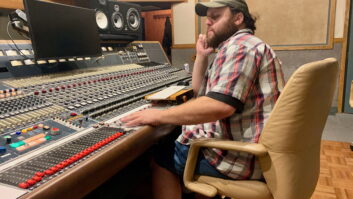Radio World’s “Guest Commentaries” section provides a platform for industry thought leaders and other readers to share their perspective on radio news, technological trends and more. If you’d like to contribute a commentary, or reply to an already published piece, send a submission to [email protected].
Last week, David Bialik shared his thoughts on why talk radio stations should be broadcasting in mono, not stereo. Now, he offers a conversation with an industry veteran on the matter.
Throughout my career, I have worked with some really smart engineers. One engineer that I was privileged to work with is Mike Byrnes, who recently retired as chief engineer of WETA(FM).
During the 1980s he was chief engineer of WAMU(FM). The station (at the time) was transitioning much of its programming away from music. Mike had the thought to turn off the 19 kHz stereo pilot during non-music shows to extend the coverage. Recently, we had a conversation about it and here is a transcript:

David Bialik: If an FM station decides to broadcast monaural and turns off the pilot, how much stronger is the signal?
Mike Byrnes: Turning off the pilot doesn’t affect the RF output so it doesn’t affect the actual measured coverage area. What it does do is lower the noise floor so that the station is more listenable over a larger area. I would guess that the acceptable listening area would increase by 15% to 20% — which would vary.
Bialik: Doesn’t the pilot turn on a stage in the receiver? And can that be fooled by a 19 kHz generator or is that detrimental?
Byrnes: 19 kHz in the FM audio signal tells the receiver to route the signal through the stereo decoder. That decoder is the source of most of the increased noise level in stereo FM broadcasting. Turning off the pilot essentially bypasses the stereo decoder, making the received audio quieter. If you substitute a 19 kHz generator for a stereo encoder you will still be telling the receiver to decode the signal in stereo. You just won’t have the L-R 38kHz carrier to decode with so you’ll get 2-channel mono.
Bialik: But would it be noisy?
Byrnes: Noisier than no pilot — yes, because you will be using the stereo decoder in the receiver. The cleanest FM is mono — no pilot.
Bialik: Were there ever complaints from listeners when the pilot went off?
Byrnes: Very early on there were questions (not complaints) when listeners noticed that their stereo light was off and they thought something might be wrong. But after a while the questions tapered off to zero — the listeners just ignored the light. I don’t think anyone today would even notice whether the light is on or off — or even if there is one. As I recall, the noise penalty incurred in broadcasting stereo is about 20 dB.
Bialik: Did anyone from the FCC ever ask why your pilot was going on and off? Was it evident that you gained listenership in the fringe areas?
Byrnes: Only [former FCC engineer] John Reiser commented — he thought it was a good idea. Stereo broadcasting did not require specific FCC authorization. Unfortunately there was no hard evidence of listenership gain. WAMU didn’t have the ability at the time to track listenership by donor zip codes like WETA does now.
Bialik: Were you Arbitron subscribers then?
Byrnes: WAMU was not a subscriber.
Bialik: Did you ever have a separate processing chain for mono?
Byrnes: Audio chain and processing was exactly the same. We just turned off the pilot and with it the 38 kHz subcarrier. No other changes.
Bialik: When in mono were you summing or just taking the left channel?
Byrnes: We were summing. Main channel is normally L+R.
Bialik: Any advantages for an HD station to go mono?
Byrnes: There’s no advantage to the HD signal. The FM signal would see the standard lower noise.
Bialik: Wouldn’t mono HD would be clearer and louder?
Byrnes: I guess you’re assigning more bits to the mono channel in mono HD so that makes sense.
[Read Bialik’s original commentary “Let’s Talk About Mono”]
David Bialik is a consultant; co-chair of the AES Technical Committee for Broadcast and Online Delivery; and chair of the Metadata Usage Working Group at the NRSC. He is former director of stream operations for CBS Radio and Entercom. His commentaries appear regularly at Radio World.







